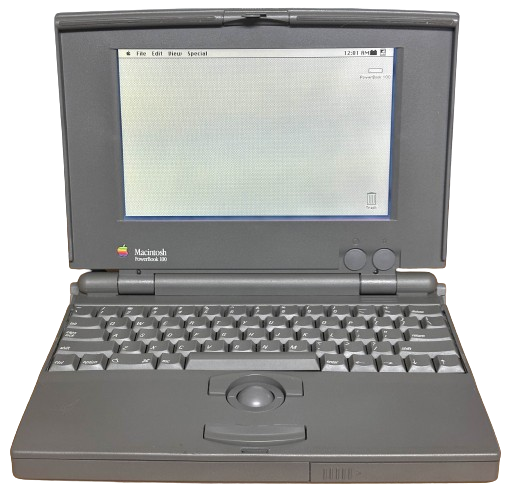
PowerBook 100
The PowerBook 100 is often considered Apple's first laptop, however, it was actually one of three. The 100, 140 and 170 were all introduced at the same time. The reason the 100 differs from the others so much is because it was largely designed for Apple by Sony, being based on the hardware design of the Macintosh Portable. It was one of Apple's last products to use the original Motorola 68000 processor, and was the only PowerBook to have one.
The 100 is notable for being the only PowerBook to use a Lead Acid battery, just like the portable did.
Specifications
| Spec | Details |
|---|---|
| Release Date | October 1991 |
| Discontinuation Date | August 1992 |
| Processor | Motorola 68000 @16MHz |
| Bus Speed | 16MHz |
| RAM | PowerBook 100 Proprietary (same connector as 140/170 RAM but different form factor) - 2MB Soldered - 8MB Maximum |
| Hard Disk | 2.5" 40-pin SCSI - 20 or 40MB Standard |
| Display | 9" Passive-Matrix Monochrome LCD @640x400 |
| GPU | Unknown |
| Main Battery | Sealed Lead Acid |
| PRAM Battery | 3x CR2430 cells (user-replaceable via door on the back) |
| Power Supply | Barrel Jack - 7.5V 2A - Apple M5651 |
| Disk Drives | None, external floppy drive available |
| PC Cards | None |
| Networking | Optional Modem |
| Other I/O | - 1x Serial - 1x ADB - 1x HDI-20 External Floppy Connector - 1x HDI-30 SCSI - 1x Line Out |
| Pointing Device | Trackball |
| Minimum Mac OS | System Software 6.0.8L |
| Maximum Mac OS | System Software 7.5.5 |
Upgrades
SSD Upgrade
See our page on SCSI SSDs for more info.
Memory Upgrades
The PowerBook 100 uses proprietary RAM cards. It is technically the same as the one that the PowerBook 140 and 170 used, but modules designed for those laptops won't clear the CPU daughterboard, so memory for the PowerBook 100 has to be designed specifically for it. Siliconinsider on Tindie sells modern new-production modules, but they aren't always in stock.
Resources
 Service Manual |
Capacitor Reference |
|---|
Common Faults & Maintenance
PowerBook 100s are very problematic machines. Getting one working is a challenge, but one that should be worth it in the end.
Capacitor Leaks
The PowerBook 100 is full of surface mount electrolytic capacitors, which now fail and leak corrosive fluid over the logic board. This issue affects 100% of PowerBook 100s. Unserviced units will power on to a blank screen and not boot. Some may still chime, others may death chime, but basically none still actually power on with original caps. Replacing the caps on the logic board and on the LCD usually restores functionality, but not always in cases where corrosion damage has occured.
Black Screen of Death
PowerBook 100s will often suffer from a black/blue screen of death due to failed capacitors leaking over the board. While replacing them fixes this problem for many, people have commonly had LCDs still not work, even after a recap. Troubleshooting this is a tricky process. It could have many different causes, and one fix that works for one person has often not worked for others. One cause of this is one or more of the inductors on the logic board next to capacitors C20, C25, C26 and C21 getting corroded by the cap juice. Two of these three inductors are 150uh value parts, and these have been linked to generating voltage for the LCD that is needed for it to function. I'm not sure about the third one. Multiple people have fixed their BSoD PowerBook by replacing these. Others have replaced them with no change.
Pink Splotches on the display
The trackball inside the PowerBook 100 will begin to press against the LCD panel when closed due to rubber bumpers on the top of the display breaking down. Over time, this has caused many of them to develop a "pink splotch" pressure mark on the display in that area, due to damage to the LCD. There is no way to fix this without replacing the display. To avoid the problem, remove the trackball from the machine before storing it closed. (It's easy!)
Hard Drive Failures - A common cause (and easy fix!)
The Connor Peripherals SCSI hard drives found in these PowerBook 100s have rubber bumpers in their head assembly. After 30 years, these bumpers have turned to sticky goop, and thus, nearly every PB 100 hard drive needs to be repaired to work again. It's a pretty easy fix - I would recommend looking up a YouTube video to do it. Just make sure your environment is clean.
Alternatively to repairing the old drive, or if the drive still won't work after repair (as mine didn't), you can install a ZuluSCSI, BlueSCSI, or similar device to convert the PowerBook to faster flash storage. There is a good chance of getting one going again though. My 100's drive didn't come back to life, but my 170's drive did.
Brittle Plastic?
The PowerBook 100's plastic predates the brittle plastic plague of the 1990s, and is still very solid. It isn't as strong as it was when new, but you won't ever see one of these with a busted hinge.
Page last updated (MM/DD/YYYY): 08/12/2024
Update Reason: page refreshed with current styling
Back-Navigation
Index < Macintosh Portal < PowerBook < PowerBook 100